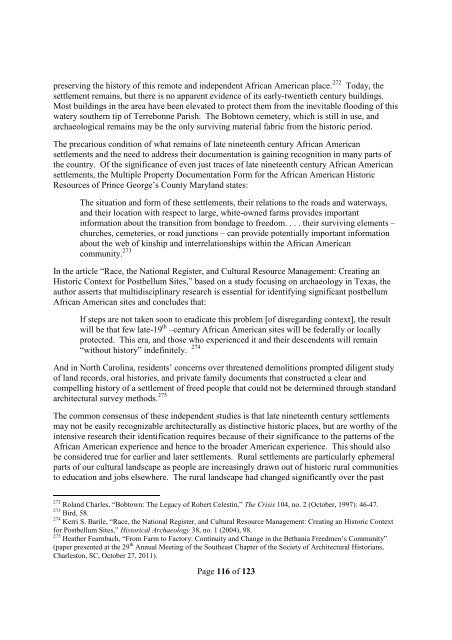The African American Experience in Louisiana
The_African_American_Experience_in_Louisiana
The_African_American_Experience_in_Louisiana
- No tags were found...
Create successful ePaper yourself
Turn your PDF publications into a flip-book with our unique Google optimized e-Paper software.
preserv<strong>in</strong>g the history of this remote and <strong>in</strong>dependent <strong>African</strong> <strong>American</strong> place. 272 Today, the<br />
settlement rema<strong>in</strong>s, but there is no apparent evidence of its early-twentieth century build<strong>in</strong>gs.<br />
Most build<strong>in</strong>gs <strong>in</strong> the area have been elevated to protect them from the <strong>in</strong>evitable flood<strong>in</strong>g of this<br />
watery southern tip of Terrebonne Parish. <strong>The</strong> Bobtown cemetery, which is still <strong>in</strong> use, and<br />
archaeological rema<strong>in</strong>s may be the only surviv<strong>in</strong>g material fabric from the historic period.<br />
<strong>The</strong> precarious condition of what rema<strong>in</strong>s of late n<strong>in</strong>eteenth century <strong>African</strong> <strong>American</strong><br />
settlements and the need to address their documentation is ga<strong>in</strong><strong>in</strong>g recognition <strong>in</strong> many parts of<br />
the country. Of the significance of even just traces of late n<strong>in</strong>eteenth century <strong>African</strong> <strong>American</strong><br />
settlements, the Multiple Property Documentation Form for the <strong>African</strong> <strong>American</strong> Historic<br />
Resources of Pr<strong>in</strong>ce George’s County Maryland states:<br />
<strong>The</strong> situation and form of these settlements, their relations to the roads and waterways,<br />
and their location with respect to large, white-owned farms provides important<br />
<strong>in</strong>formation about the transition from bondage to freedom. . . . their surviv<strong>in</strong>g elements –<br />
churches, cemeteries, or road junctions – can provide potentially important <strong>in</strong>formation<br />
about the web of k<strong>in</strong>ship and <strong>in</strong>terrelationships with<strong>in</strong> the <strong>African</strong> <strong>American</strong><br />
community. 273<br />
In the article “Race, the National Register, and Cultural Resource Management: Creat<strong>in</strong>g an<br />
Historic Context for Postbellum Sites,” based on a study focus<strong>in</strong>g on archaeology <strong>in</strong> Texas, the<br />
author asserts that multidiscipl<strong>in</strong>ary research is essential for identify<strong>in</strong>g significant postbellum<br />
<strong>African</strong> <strong>American</strong> sites and concludes that:<br />
If steps are not taken soon to eradicate this problem [of disregard<strong>in</strong>g context], the result<br />
will be that few late-19 th –century <strong>African</strong> <strong>American</strong> sites will be federally or locally<br />
protected. This era, and those who experienced it and their descendents will rema<strong>in</strong><br />
274<br />
“without history” <strong>in</strong>def<strong>in</strong>itely.<br />
And <strong>in</strong> North Carol<strong>in</strong>a, residents’ concerns over threatened demolitions prompted diligent study<br />
of land records, oral histories, and private family documents that constructed a clear and<br />
compell<strong>in</strong>g history of a settlement of freed people that could not be determ<strong>in</strong>ed through standard<br />
architectural survey methods. 275<br />
<strong>The</strong> common consensus of these <strong>in</strong>dependent studies is that late n<strong>in</strong>eteenth century settlements<br />
may not be easily recognizable architecturally as dist<strong>in</strong>ctive historic places, but are worthy of the<br />
<strong>in</strong>tensive research their identification requires because of their significance to the patterns of the<br />
<strong>African</strong> <strong>American</strong> experience and hence to the broader <strong>American</strong> experience. This should also<br />
be considered true for earlier and later settlements. Rural settlements are particularly ephemeral<br />
parts of our cultural landscape as people are <strong>in</strong>creas<strong>in</strong>gly drawn out of historic rural communities<br />
to education and jobs elsewhere. <strong>The</strong> rural landscape had changed significantly over the past<br />
272 Roland Charles, “Bobtown: <strong>The</strong> Legacy of Robert Celest<strong>in</strong>,” <strong>The</strong> Crisis 104, no. 2 (October, 1997): 46-47.<br />
273 Bird, 58.<br />
274 Kerri S. Barile, “Race, the National Register, and Cultural Resource Management: Creat<strong>in</strong>g an Historic Context<br />
for Postbellum Sites,” Historical Archaeology 38, no. 1 (2004), 98.<br />
275 Heather Fearnbach, “From Farm to Factory: Cont<strong>in</strong>uity and Change <strong>in</strong> the Bethania Freedmen’s Community”<br />
(paper presented at the 29 th Annual Meet<strong>in</strong>g of the Southeast Chapter of the Society of Architectural Historians,<br />
Charleston, SC, October 27, 2011).<br />
Page 116 of 123


